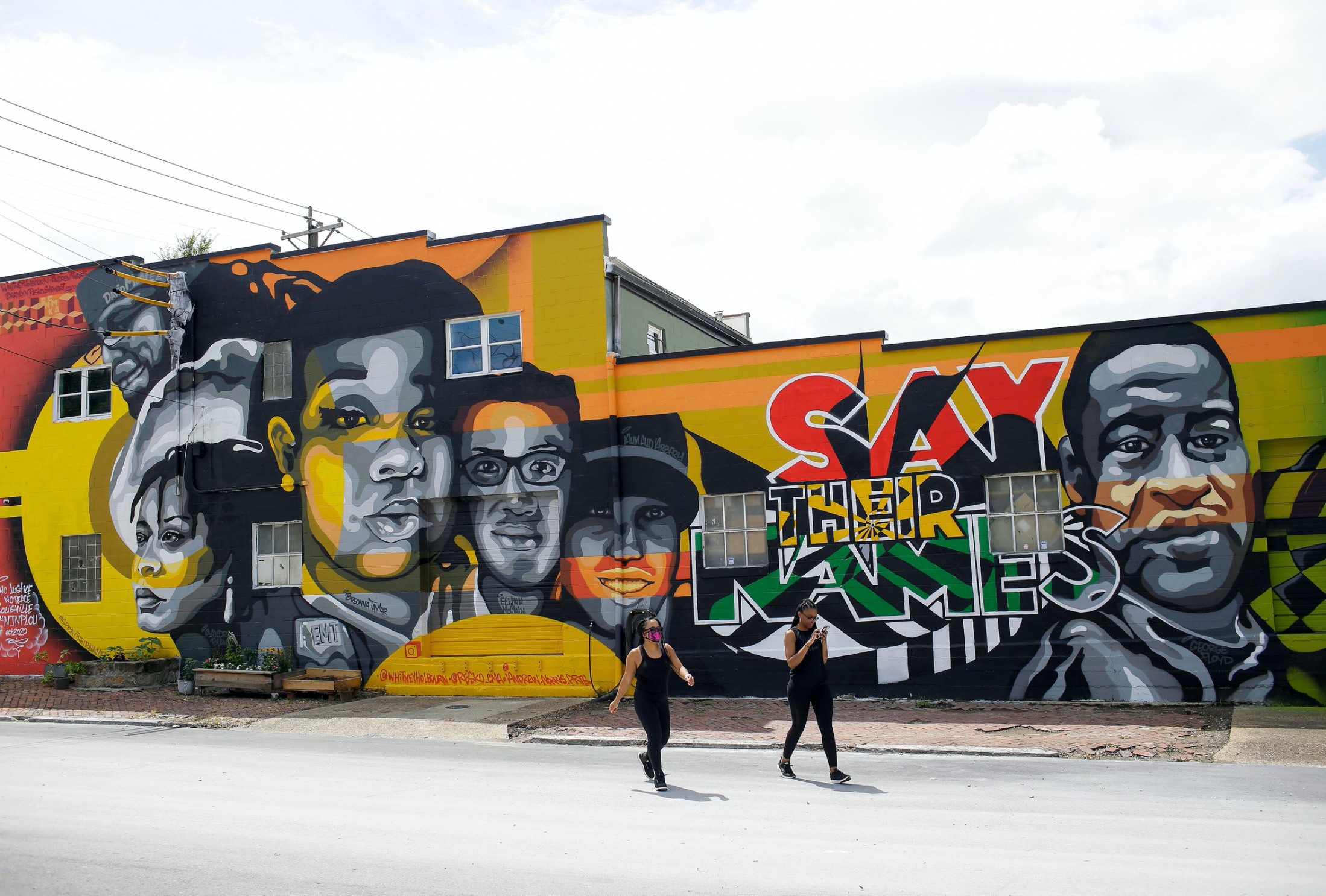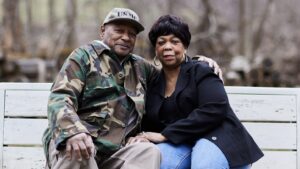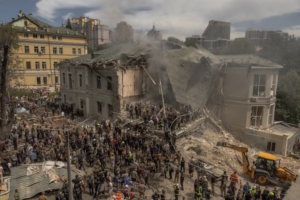An exclusive analysis from VICE News reveals the disturbing scope of gun violence and killings at protests since George Floyd’s death — and who is doing the shooting.
On the night of July 25 in Austin, Texas, a 28-year-old Air Force veteran named Garrett Foster attended a peaceful protest against police brutality armed with an AK-47 rifle. Garrett, who was white, was there that evening with his fiancée, Whitney Mitchell, a Black quadruple amputee for whom he was also a full-time caretaker.
They were with a small crowd of people standing on a busy corner, with signs saying things like “Honk for Justice.” A local journalist was broadcasting the scene live on Periscope, and briefly interviewed Foster. “When did you start carrying?” he asked. “Well, my roommate got arrested, and they stopped letting us march anywhere, so I started carrying,” Foster replied.
Hours later, Foster was shot dead. Bystander video shows protesters marching down the street and chanting. A car starts honking, trying to push through the crowd. Someone yells, “Everybody back up!” Seconds later, five gunshots are heard, and people start screaming.
Daniel Perry, who is active-duty U.S. Army, later turned himself in, claiming that Foster had approached his car and threatened him. Perry, who was armed with a handgun, says he shot Foster in self-defense, and he is not currently facing charges.
In 2020, Americans bought guns in record numbers. They also brought them to Black Lives Matter protests, adding a menacing element to increasingly tense confrontations between protesters, counterprotesters, and cops. These guns are not just for show; an analysis by VICE News shows there have been at least 70 incidents involving guns since George Floyd was killed by police in Minneapolis in late May, sparking protests across the country. 21 of those incidents left 22 people dead.
It’s important to note that of the 10,600 demonstrations in the U.S. tallied by the Armed Conflict Location and Event Data Project, 96% were peaceful. But the presence of guns at protests has raised the stakes, and shooting deaths only tell part of the story. In addition to deaths by gunfire, VICE News’ analysis also tallied incidents of “brandishing,” where someone threatens by pointing a gun; random shots fired; shootings; shootings that caused injury; and shootings that killed.
Our data collection focused primarily on incidents of gun violence that were linked to a protest. We compiled incidents from social media, local news reports, and police reports. Researcher Alexander Reid Ross, a lecturer at Portland State University and author of “Against the Fascist Creep,” also contributed data.
Here are some key data points on shootings at protests since George Floyd was killed on May 25, according to our analysis:
Total gun incidents: 70
Deaths due to gun violence at Black Lives Matter protests: 22
Shootings that resulted in non-fatal injuries: 14
Times guns were brandished in a threatening manner: 26
Incidents where Black Lives Matter protesters were threatened, shot at, or killed: 33
Incidents where counterprotesters were threatened, shot at, or killed: 12
We also looked at who’s being targeted by shootings or threatened with gun violence, where it was possible to discern. Of the 26 incidents of brandishing weapons, for example, 21 were targeting Black Lives Matter protesters. This includes Patricia and Mark McCloskey, the wealthy St. Louis couple who threatened protesters from the lawn of their mansion (they were later invited to speak at the RNC), as well as an incident in Portland, where Proud Boy supporter Alan Swinney pointed a gun at protesters.
“When you have groups of protesters and counterprotesters of hotly contested issues, with one or both sides bringing guns into the mix, it’s just a volatile combination,” said Adam Skaggs, chief counsel and policy director for the Giffords Law Center to Prevent Gun Violence. “In some ways, it’s incredibly fortunate there has been as few shootings and killings as we’ve seen.”
Who is doing the shooting?
Garrett Foster’s fatal shooting in Austin was just one violent incident in a particularly violent July weekend. That same weekend, three people were injured by gunfire in Louisville, Kentucky, when a member of the Not Fucking Around Coalition (NFAC), a Black militia, accidentally fired their weapon during a protest. Two people were injured by gunfire in Aurora, Colorado, when a protester started shooting at a jeep that was plowing through the crowd at a protest demanding justice for Elijah McClain, the 23-year-old Black man killed last year in a police chokehold. In Weatherford, Texas, a man was arrested for pointing a sniper rifle at protesters who were demanding the removal of a Confederate statue.
In Richmond, Virginia, a man got out of his car and fired into the ground during an argument with Black Lives Matter protesters. In Eugene, Oregon, a truck driver pointed his gun at protesters and said “Get the fuck out of my way.” A protester ran up to the driver’s window and pointed his own gun right back.
Experts say the creeping culture of vigilantism in the U.S. is partially to blame for the uptick in gun violence at protests, from armed protesters gathering outside state Capitols to rally against COVID-19 lockdowns, to groups of armed men patrolling their neighborhoods amid conspiracy theories of a coming “antifa” invasion. This summer, memes glorifying the “Rooftop Koreans” — the heavily-armed Korean store owners who defended their businesses during the 1992 Rodney King riots in Los Angeles — went viral among right-wing, Second Amendment types.
But it’s not only right-wingers who are armed. In some cases, left-aligned activists have also brought guns to protests—and at times, used them.
VICE News identified at least 13 incidents since May where gun threats or gunfire came from left-leaning protesters. One incident on August 3 involved a member of Redneck Revolt, an antifascist militia, who allegedly pointed her gun at a man who tried to drive through a crowd of protesters in Colorado Springs. Groups like Redneck Revolt often position themselves as security for antiracist protesters.
“When other people are out with rifles, we’ll be out with rifles,” one leftist gun group, explaining the growing interest in firearms among leftists, told the Guardian last year. Others have argued that police are less likely to use force on protesters when members of the crowd are heavily armed.
Adding to the mix are some relatively new armed movements. For example, the Hawaiian shirt-clad Boogaloo Bois have shown up heavily armed to protests across the country, often in pursuit of a violent standoff with police. NFAC, which includes many Black veterans, also appeared on the scene in Stone Mountain, Georgia, and Louisville.
Many of the incidents fall into the category of “political violence” — an umbrella term that describes violent acts committed to advance political goals, explained Joe Young, an expert on political violence and a professor at the School of Public Affairs at the American University. There’s political violence against other civilians, like threatening an ideological opponent with a gun — or political violence against the government, which could be in the form of a riot. Police brutality, or heavy-handed crowd-control tactics, are examples of state political violence. Our data analysis focused on political violence, but sometimes the distinction from criminal violence can get a little fuzzy, especially during the chaos of riots, when opportunists may seek to exploit unrest for their own gain.
What is clear is that increasingly armed protests have raised the stakes and the potential for violence, and despite the Trump administration’s branding of antifascist protesters as domestic terrorists, the majority of gun violence at protests has been committed by individuals who weren’t affiliated with the main protest movement.
Some parts of the U.S. have emerged as particular hotspots for gun violence at protests. For example, Oregon accounted for the highest number of incidents: eight in total, which took place in Portland, Eugene, and Medford. This isn’t surprising, given the ongoing political tensions between leftist protesters and pro-Trump or far-right groups. Kentucky accounted for the second-highest number of incidents. Again, this isn’t too surprising: Louisville has been a hub for protest activity amid renewed anger over the death of Breonna Taylor, who was killed by local police in March.
How are people dying?
Two recent deadly shootings at protests put a national spotlight on the issues of guns, political violence, and vigilantism. On August 25, 17-year-old Kyle Rittenhouse traveled to Kenosha, Wisconsin, armed with an AR-style rifle. Rittenhouse, a former police cadet, told the Daily Caller that he was there to defend public property from protester damage. Later in the evening, following an altercation between militia members and protesters, he shot three people — two fatally. He’s facing murder charges.
Less than a week later, Michael Reinoehl, 48, shot and killed a supporter of far-right Patriot Prayer in Portland. The incident was the culmination of simmering tensions between leftist protesters and far-right groups. Reinoehl told VICE News that he’d acted in self-defense. Hours after a portion of the interview was published on Vice.com, he was shot dead by a federal task force led by U.S. Marshals.
But those were just two of 20 fatal shooting incidents linked to protests this summer.
Six of those deadly shootings happened while protests were ongoing, but it’s not yet clear if they were directly related to the protests. That includes the fatal shootings of two Black men in Indianapolis on May 30. Former Indiana University football player Chris Beaty was shot dead that night, but there have been no arrests so far. Dorian Murrell, 18, was shot dead by Tyler Newby, 29, who is white. Newby is facing murder charges.
At least four deadly shootings were committed by civilians against protesters, including the two killed by Rittenhouse in Kenosha. That includes the fatal shooting of Calvin Horton Jr., a 42-year-old Black man, who was shot dead by John Rieple, a white pawnshop owner, on May 27 in Minneapolis — two days after Floyd was killed by police. Rieple claimed he was defending his business from looters. Renowned civil rights attorney Ben Crump is representing Horton’s family; Crump says video footage shows that Rieple was safely inside his business and shooting outwards into the crowd. Rieple was arrested following the shooting but hasn’t yet been charged.
On May 30, Jake Gardner, a white Nebraska bar owner, shot and killed James Scurlock, a 22-year-old unarmed Black man, during protests against police brutality in Omaha. The DA initially declined to press charges against Gardner, on the basis that he “feared for his own life or serious bodily injury.” A grand jury disagreed, and recently indicted Gardner on four felony charges, including manslaughter. Gardner died by suicide a week later.
The fatal shooting during a Black Lives Matter protest in Austin, Texas, on July 25 also fell into this category. U.S. soldier Daniel Perry released a statement through his lawyer saying he had mistakenly driven into the crowd of protesters, and shot Foster because he’d approached his car window with his AK-47 raised.
Three deadly shootings were attributed to individuals who were involved in protests, including the August 29 shooting in Portland. That also includes a fatal shooting in Louisville, Kentucky, on July 27. Witnesses described Stephen Lopez, 23, as a regular participant in the Black Lives Matter protests. He was often not wearing shoes, had serious untreated mental health issues, and had been involved in several disturbances at the protest encampment in Jefferson Park. He’d had an altercation with another protester earlier in the day, and later opened fire, allegedly shooting photographer Tyler Gerth in the face, killing him. Several bystanders returned fire and shot Lopez in the leg. Lopez survived and is facing charges for murder and wanton endangerment.
The third shooting attributed to protesters took place in Seattle’s autonomous CHOP zone on June 29. Two teenagers had allegedly stolen a Jeep, and attempted to drive into the CHOP zone thinking they’d have cover from police there. Armed protesters guarding the periphery opened fire, killing one.
Another three deadly shootings were labeled as likely criminal acts that took place in the vicinity of protests. That includes another fatal shooting in Seattle’s CHOP zone on June 20, involving two teenagers who reportedly had an ongoing feud. A bystander was shot in Cicero, a Chicago suburb, amid looting on June 1. And on June 2, the security guard of a pawn shop was shot dead during looting in St. Louis.
The fatal shooting of a federal security officer outside a courthouse in Oakland, California on May 29 was framed by the Trump Administration and the media as evidence that the Black Lives Matter movement was inherently lawless and violent. Weeks later, Air Force Staff Sgt. Steven Carrillo, who had ties to the anti-government Boogaloo movement, was arrested for the ambush attack in Oakland, and the murder of another law enforcement officer.
Finally, three fatal shootings at protests were attributed to law enforcement. Jorge Gomez, 25, was seen protesting while open-carrying in Las Vegas on June 2. Later that night, he was shot by police; they said he walked toward them and raised his gun. His family has since filed a federal lawsuit against the police department. Marquis Tousant, 23, was shot dead by police following protests in Davenport, Iowa, on June 1. Investigators concluded that the shooting was justified because he had fired first.
That same night, David McAtee, the owner of a popular barbecue restaurant in Louisville, was shot dead by the Kentucky National Guard. McAtee, a Black man, had a reputation for giving free food to law enforcement and members of his community who were hard up. What exactly happened in the moments leading to McAtee’s death is under local, state, and federal investigation. An analysis of video footage by the New York Times concluded that law enforcement were firing pepper balls at McAtee’s restaurant, and one nearly hit his niece on the head. McAtee had a gun on him, and officials say he shot first, so National Guard soldiers returned fire. This week, McAtee’s family filed a wrongful death suit against the Louisville Police and the National Guard over his death.
A new era of political violence?
Besides gun violence that caused deaths, other times when guns have been fired during protests, the perpetrators and intent were not always clear.
Six incidents were labeled “random shots fired.” This category is the hardest to pin down or determine a motivation or target. All six incidents took place in the earliest and angriest stage of the protests, between May 28 and June 2. These incidents also rely on witness testimony or social media posts (which might have mistaken firecrackers or other explosives for gunshots) or police reports, which aren’t always reliable either.
During a protest on May 31 in Albuquerque, New Mexico, police said that a total of 33 shots were fired. On May 28, video posted to social media showed protesters running away from what sounded like five gunshots fired in their direction in Denver. There were also reports of gunfire during protests in Minneapolis and in Richmond, Virginia.
Another five incidents were categorized as shootings. That includes an incident in Salisbury, North Carolina, on May 31, when two men fired their weapons near protesters at a Confederate statue. One of the men arrested has ties to a neo-Confederate biker gang, according to the Southern Poverty Law Center.
That category also includes a shooting on August 15 in Portland, when a man aligned with the far-right shot into a crowd of Black Lives Matter and antifascist protesters. He’s since been charged with unlawful use of a weapon, reckless endangerment, menacing, and discharging a firearm in the city.
There were also at least 14 shootings this summer that caused injury. The most recent example was in Louisville last week, amid protests following the decision to only press charges against one officer involved in the death of Breonna Taylor. During the unrest that followed, a protester opened fire on police officers, injuring two.
There were three other cases where police officers were shot and injured during protests, in Milwaukee, St. Louis, Las Vegas, police officers were shot and injured. Seven people were injured by gunfire during a protest on May 28 in Louisville, where protesters were demanding justice for Taylor.
On June 16, a member of the New Mexico Civil Guard, a local militia, shot a protester during a dispute over the statue of a Spanish conquistador in Albuquerque. He’s since been charged with aggravated battery with a deadly weapon.
Young, at the American University, says it’s hard to say definitively that the apparent increase of guns at protests means that the U.S. is entering a new era of political violence. For one thing, people have more guns today than ever before. This year in particular has seen soaring gun sales: Approximately 19 million guns were sold in the first six months of 2020, representing more than one firearm per every 20 Americans. In June alone, Americans bought more than 2.3 million guns — a 145% increase compared to June 2019.
“If we look at the more violent protests in the U.S. in the 1960s, people often didn’t bring guns,” said Young. “They hit each other with bats and did violent things to each other.”
Guns aren’t the only way people are getting hurt at protests. There’s been an alarming surge in car-ramming attacks against protesters over the last few months. Since May, there have been over 100 incidents of drivers going into crowds of protesters, and nearly half of those were confirmed to be intentional, according to research by Ari Weil, a terrorism researcher at the University of Chicago’s Chicago Project on Security and Threats.
Still, Young says the addition of guns makes him “troubled.” “Guns just raise the stakes in everything,” he said. “There’s intense hyper-partisanship and polarization in our country, I don’t think there’s any debate on that. Democracy is an equilibrium that we’ll solve things nonviolently. That equilibrium becomes less tenable when either side says, ‘Oh, actually, let’s use violence.”




